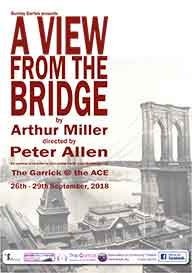Association of Community Theatre

A VIEW FROM THE BRIDGE
Burnley Garrick Club
by Arthur Miller
Directed by Peter Allen
 Arthur Miller’s psychological play about the hard life of Brooklyn immigrants forging a living on the docks of Red Hook can be viewed as a social drama, too.
Arthur Miller’s psychological play about the hard life of Brooklyn immigrants forging a living on the docks of Red Hook can be viewed as a social drama, too.
Longshoreman, Eddie Carbone is revealed as having an obsessive love for his niece Catherine. It is a love that flares into frenzied jealousy when Catherine falls for Rodolfo, one of the two illegal immigrants whom Eddie, and his wife Beatrice are harbouring. There is also the underlying social level of an immigrant community living by almost tribal customs and a code which is broken by Eddie’s betraying his two Italian brethren to the authorities, the consequences of which end in tragedy.
On a minimal set, the back wall of which evoked New York with a superb painting of the Statue of Liberty stage right, and the Empire State Building stage left, the drama unfolded. In the centre was the main exit to the Carbone’s apartment via a slightly raised platform. As the play progressed I wondered whether or not it would have been an advantage to have had two levels, one to indicate the street and the other to indicate the living quarters. Strategically placed chairs and crates were all that were necessary for the many scenes contained within the play. The space created allowed the cast members plenty of room in which to move.
This is very much Eddie Carbone’s play, portrayed by a very dominant John Cummings who towered above the unfolding events. John was by turns the blustering hard-man, and then a much put-upon victim of circumstances, ignoring the fact that all events were of his own making. As his put-upon spouse, Lynne Cummings was the archetypical Italian wife, allowing her husband to dominate, but also very determined in her shielding of her niece, Catherine, played by Rachel Bailey, from the less than healthy attentions of Eddie. Lynne’s awareness of her husband’s attention to his niece was beautifully paced and as each layer of her disquiet was revealed, we came to understand the tension that was building up within the household as Catherine was anxious to have a secretarial career on the recommendation of her college tutor.
I have never seen Lynne play a better role than this. Always in character, keeping a perfect Italian/American accent throughout she dominated the proceedings at appropriate times. A superb performance.
Into this family mix came the two cousins from Italy, seeking fortune and a better life in the New World.
James Bateman and Simon Bailey were the two illegal immigrants, Rudolpho and Marco, entering this new world in which they were attempting to improve their lives.
James played the shy, initially diffident younger cousin, almost instantly smitten with Catherine, who responded to his hesitant overtures towards her. I am not too sure about the wig though as hair colouring has to complement the character rather than be too obvious.
His cousin, Marco, played by Simon Bailey, remained throughout the more volatile character of the two of them. He was anxious to live in America and to make money for his family back in Italy, but had no wish to lose his own identity in the process. Maintaining his Italianate English throughout, he was by turns quiet and thoughtful, and then quite volatile.
There were fine performances from all the principal players, who were introduced by Arthur Miller’s technique of using Mr Alfieri, Alan Bailey, as a Greek chorus, setting the scenes, and moving the story along. As a lawyer and a friend of the family, he had, by turns, to sympathise with events and attitudes, but offer practical advice as to exactly what was the law. There was a well-timed scene when Alfieri was explaining to Eddie, that despite Eddie’s contention that Rudolpho, “ain’t right”, the law made no recognition of this and that indeed, Catherine and Rudolpho were able to be married.
During the interplay between the various characters, we came to learn of the community ethos that existed amongst the Italian immigrants, legal or otherwise. Although when Marco says, "all the law is not in a book," we came fully to appreciate what it meant to be “a community”.
All the supporting roles were well played by Stephen Dixon, doubling up as friend Louis, and as an Immigration Officer. Another friend of the family, Michael Mullen played Mike, and a second Immigration Officer. Walk on roles were played by Garrick members.
In front of a very appreciative audience, this seething portrait of community life was well presented in the opening play of the Garrick’s new season, of one of Arthur Miller’s more famous works, superbly directed by Peter Allen who had moulded his cast into a very believable immigrant Italian community.
The sound and lighting designs were excellent and up to the Garrick’s usual high standard.
It was a great pleasure to be reacquainted with this classic American play by a classic American author.